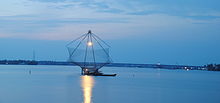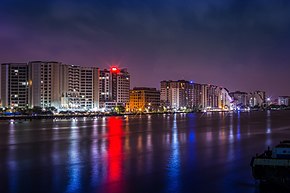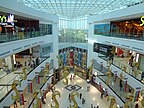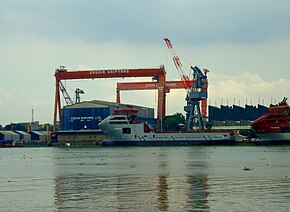
A | B | C | D | E | F | G | H | CH | I | J | K | L | M | N | O | P | Q | R | S | T | U | V | W | X | Y | Z | 0 | 1 | 2 | 3 | 4 | 5 | 6 | 7 | 8 | 9
This article may require cleanup to meet Wikipedia's quality standards. The specific problem is: references and uncited sections. (September 2023) |
Ernakulam district | |
|---|---|
|
Clockwise from top: Kochi skyline, Jawaharlal Nehru Stadium, International Container Transshipment Terminal, Lulu International Shopping Mall, Cochin Shipyard, Kochi Marina, Cochin International Airport, and Kochi Metro | |
 Location in Kerala | |
| Coordinates: 10°00′N 76°20′E / 10.00°N 76.33°E | |
| Country | |
| State | Kerala |
| Named for | Rishinagakulam[citation needed] |
| Headquarters | Kakkanad, Kochi |
| Government | |
| • Collector | N.S.K. Umesh , IAS |
| • Commissioner & IG (Kochi) | C. Nagaraju, IPS |
| • S.P (Ernakulam Rural) | K.Karthik, IPS |
| • DFO | A. Renjan, IFS |
| Area | |
| • Total | 2,924 km2 (1,129 sq mi) |
| • Rank | 6th |
| Population (2018) | |
| • Total | 3,427,659[1] |
| • Density | 1,119/km2 (2,900/sq mi) |
| Languages | |
| • Official | Malayalam |
| Time zone | UTC+5:30 (IST) |
| ISO 3166 code | IN-KL-KO, IN-KL |
| Vehicle registration |
|
| HDI (2005) | very high |
| Website | ernakulam |

Ernakulam (IPA: [erɐɳɐːguɭɐm] ; ISO: Eṟaṇākuḷaṁ) is one of the 14 districts in the Indian state of Kerala, and takes its name from the eponymous city division in Kochi. It is situated in the central part of the state, spans an area of about 2,924 square kilometres (1,129 sq mi), and is home to over 9% of Kerala's population. Its headquarters are located at Kakkanad. The district includes Kochi, also known as the commercial capital of Kerala, which is famous for its ancient churches, Hindu temples, synagogues and mosques.
The district includes the largest metropolitan region of the state: Greater Cochin. Ernakulam district yields the highest revenue and the largest number of industries in the state.[4] Ernakulam is the third most populous district in Kerala, after Malappuram and Thiruvananthapuram (out of 14 districts).[5] The district also hosts the highest number of international and domestic tourists in Kerala state.
The most commonly spoken language in Ernakulam is Malayalam. English is widely used, mostly in business circles. Ernakulam became India's first district to have 100 percent banking or full "meaningful financial inclusion" in 2012.[6][7]
Ernakulam has a high Human Development Index of 0.801 (UNHDP report 2005), which is one of the highest in India.[8]
Etymology
This section is empty. You can help by adding to it. (August 2023) |
History


Ernakulam has played a part in the political history of south India since ancient times. The Jews, Syrians, Arabs, Chinese, Dutch, British, and Portuguese seafarers followed the sea route to the Kingdom of Cochin and left their impressions on the town. The port at Kozhikode held superior economic and political position in medieval Kerala coast, while Kannur, Kollam, and Kochi, were commercially important secondary ports, where the traders from various parts of the world would gather.[9] In 1664, the municipality of Fort Kochi was established by Dutch Malabar, making it the first municipality in Indian subcontinent, which got dissolved when the Dutch authority got weaker in 18th century.[10] In 1896, the Maharaja of Cochin initiated local administration by forming a town council in Ernakulam. Initially, The district's headquarters were located in the portion of the city known as Ernakulam, which gave the district its name; the headquarters was relocated afterwards to Kakkanad.
In the year 1998, Kuttampuzha village was added to the district from Idukki district following which the district got a political boundary with neighbouring state of Tamil Nadu. There is no interstate road that connects the district with the neighbouring state through this border.
Geography
This section needs additional citations for verification. (September 2020) |
The Ernakulam district covers an area of 3,068 km2 (1,185 sq mi) on the Western Coastal Plains of India. It is surrounded by the Thrissur District to the north, the Idukki District to the east, Alappuzha and Kottayam districts to the south and the Laccadive Sea to the west. The Anamalais occupy a large part of the district, consisting of the forest areas around Pooyamkutty and the Idamalayar Dam. The range also extends into Thrissur, Palakkad, and Idukki districts, as well as Coimbatore and Tiruppur districts of Tamil Nadu. The district is divided geographically into highland, midland, and coastal area. The altitude of the highlands is about 300 m (980 ft). The Periyar River, Kerala's longest, flows through all the taluks except Muvattupuzha. The Muvattupuzha River and a branch of the Chalakkudy River also flow through the district. The average yearly rainfall in the district is 3,432 mm (135.1 in). The district has a moderate climate and mostly falls within the Malabar Coast moist forests ecoregion, while the highlands are part of the South Western Ghats moist deciduous forests ecoregion. The Anamudi is the tallest peak in South India, on the border of Ernakulam and Idukki districts. Some parts of the Idamalayar Reserve Forest and Mankulam Forest Division have Sholas but these parts are inaccessible by road. The Idamalayar Reserve Forest, and Edamalakkudy. Many types of sand, soil, and rocks are abundant here. Cochin International Airport is located in the northern part of the district at Nedumbassery, Kochi.
The district houses two Urban Agglomerations, Kochi and Kothamangalam. Kochi is the largest city in the state, and 17th most populous in the country according to the Ministry of Housing and Urban Affairs rankings based on the 2011 Census, with an area of over 843km2 and 2.12 million population.
Topography
The district is divided into three parts: lowland, midland, and the highland that consist of seaboard, plains, and hills and forests respectively. 20 percent of the total area are lowlands. The forests in the eastern part of the district are mostly remote, forming a part of the Anamalais. The highest peak is the Anamudi. The midland consists mainly of plain land and a group of islands that naturally drain water via backwaters and canals. The hilly or eastern portion is formed by a section of the Western Ghats. Muvattupuzha and Kothamangalam taluks, which were initially parts of the Kottayam district and constitute the highlands. Muvattupuzhayar and Periyar are the main rivers, of which the latter flows through Muvattupuzha, Aluva, Kunnathunad and Parur taluks. During the rainy season these rivers are full and heavy floods affect the low-lying areas on the banks, but in the summer season, they generally go dry and narrow. The Periyar is stretched over a length of 229 km (142 mi).
Forest and wildlife

The flora of this district is tropical. The heavy rainfall combined with moderate temperatures and fertile soil support abundant vegetation. Many of the common plants are found in the coastal area, which forms the lowland region. The midland region is occupied by coconut palms, paddy, tapioca, pepper, pineapple and pulses. The lower slopes of the highland region have teak and rubber.
Mangalavanam Bird Sanctuary

Mangalavanam Bird Sanctuary is located at the centre of Kochi. It covers 2.74 ha (6.8 acres),[11] supports many species of mangroves and is a nesting ground for a variety of migratory birds. The Managalavanam is called the "green lung of Kochi",[12] considering its role in controlling the city's air pollution.[13]
Thattekad Bird Sanctuary
Thattekad Bird Sanctuary lies on the northern bank of the Periyar River and covers about 25 km2 (10 sq mi). It was founded by ornithologist Salim Ali. The sanctuary is 80 km (50 mi) from Kochi. Birds found here include falcons, jungle fowl, water hens, and hornbills. The flora of this area consists mainly of plantations of teak, rosewood, and mahogany. Further on the road, Pooyamkutty forest of the Anamalais is reached.
Climate
| Climate data for Kochi | |||||||||||||
|---|---|---|---|---|---|---|---|---|---|---|---|---|---|
| Month | Jan | Feb | Mar | Apr | May | Jun | Jul | Aug | Sep | Oct | Nov | Dec | Year |
| Record high °C (°F) | 35 (95) |
37 (99) |
37 (99) |
34 (93) |
35 (95) |
33 (91) |
35 (95) |
35 (95) |
38 (100) |
35 (95) |
34 (93) |
33 (91) |
38 (100) |
| Mean daily maximum °C (°F) | 30 (86) |
31 (88) |
31 (88) |
31 (88) |
31 (88) |
28 (82) |
28 (82) |
28 (82) |
28 (82) |
29 (84) |
30 (86) |
30 (86) |
30 (86) |
| Mean daily minimum °C (°F) | 23 (73) |
25 (77) |
26 (79) |
26 (79) |
26 (79) |
25 (77) |
24 (75) |
24 (75) |
25 (77) |
25 (77) |
25 (77) |
23 (73) |
25 (77) |
| Record low °C (°F) | 17 (63) |
18 (64) |
20 (68) |
21 (70) |
22 (72) |
21 (70) |
21 (70) |
20 (68) |
22 (72) |
20 (68) |
20 (68) |
19 (66) |
17 (63) |
| Average precipitation mm (inches) | 21.9 (0.86) |
22.9 (0.90) |
35.3 (1.39) |
124.0 (4.88) |
395.7 (15.58) |
720.7 (28.37) |
697.2 (27.45) |
367.8 (14.48) |
289.4 (11.39) |
302.3 (11.90) |
175.1 (6.89) |
48.3 (1.90) |
3,228.3 (127.10) |
| Source 1: [14] | |||||||||||||
| Source 2: [15] | |||||||||||||
Economy



Ernakulam district is the richest district in Kerala and is the biggest commercial centre in the state of Kerala. It contributes the most to the state exchequer in terms of GSVA and tax revenues. It has the highest literacy rate as well as the highest per capita income in the state, along with having the greatest number of commercialised banks, startups and large-scale industries & MSMEs in the state. Its M.G. Road is home to some of Kerala's most prestigious enterprises. Kochi is also the headquarters of some large companies like Lulu Group International, Federal Bank, Geojit, V-Guard, and Muthoot.
The sea along the entire coast of the district and its backwaters are the habitat of various kinds of fish that supply both marine and inland fisheries.
Agriculture
The eastern part of Ernakulam is primarily agrarian in nature. Rice is the principal crop cultivated in the wetlands. The district is the largest producer of nutmeg and pineapple in the state: more than 55% of pineapples produced in the state is cultivated in the district. Rubber is the most cultivated plantation crop in the district and the district is the second-largest producer of rubber in the state behind Kottayam. Other important crops cultivated in the district are tapioca, black pepper, areca nut, coconut, turmeric, banana, and plantain.
Education

Ernakulam is the first district in India to have 100 percent literacy by 1990. In fact Kochi has the highest literacy rate for any city in the country with over 20 lakhs population. Pothanikkad is the first village in India that achieved 100 percent literacy according to state literacy programme is in this district.[citation needed]
There are three prominent universities in Ernakulam: Sree Sankaracharya University of Sanskrit in Kalady, Cochin University of Science and Technology in Kalamassery, and Kerala University of Fisheries and Ocean Studies in Kochi. The district has the most educational institutions in the state; as of 2019, there are 476 fully high-tech schools in Ernakulam.[16]
In 2017, Ernakulam district administration launched the Roshni project, which aims to provide Malayalam education to migrant children. It supported 1,265 migrant workers’ children from lower primary to high school.[17]
Divisions
There are two revenue divisions: Fort Kochi and Muvattupuzha. The municipal corporation is in Kochi.
Taluks
The district has the most taluks in the state. The district is divided by two revenue divisions with seven taluks.
Municipalities
Interestingly, Ernakulam district has the most municipalities in the state.
A criticism that has been centered around this fact is that despite municipalities like Aluva, Kalamassery, Thrikkakara, Maradu, Tripunithura and Eloor becoming assimilated into Kochi city, they still exist as individual municipalities instead of being under Kochi Corporation. Surprisingly the corporation has not amended its limits for over half a century, since 1967 to be precise. The corporation was the largest in area and population when it was formed, and all these regions were panchayaths back then. Instead of adding them to the corporation when these regions started developing due to the urban expansion of Kochi city, they were made into separate municipalities thus largely handicapping the corporation. Now the call to expand these outdated limits for a better unified administration for the entire city of Kochi is a strong public demand.[18]
Parliamentary Constituencies
- Ernakulam Parliamentary Constituency
- Chalakudy Parliamentary Constituency (partially)
- Idukki Parliamentary Constituency (parts of Muvattupuzha taluk and Kothamangalam taluk)
- Kottayam Parliamentary Constituency (parts of Muvattupuzha taluk and Kanayannur taluk)
Assembly Constituencies
Demographics
| Year | Pop. | ±% p.a. |
|---|---|---|
| 1901 | 646,235 | — |
| 1911 | 735,267 | +1.30% |
| 1921 | 789,311 | +0.71% |
| 1931 | 982,731 | +2.22% |
| 1941 | 1,172,292 | +1.78% |
| 1951 | 1,393,679 | +1.74% |
| 1961 | 1,702,740 | +2.02% |
| 1971 | 2,170,820 | +2.46% |
| 1981 | 2,549,255 | +1.62% |
| 1991 | 2,840,279 | +1.09% |
| 2001 | 3,105,798 | +0.90% |
| 2011 | 3,282,388 | +0.55% |
| 2018 | 3,427,659 | +0.62% |
| source:[19] | ||
According to the 2018 Statistics Report, Ernakulam has a population of 3,427,659.[1] The 2011 Census of India reports that the district is ranked 104th most populous in India out of 640.[5] The district has a population density of 1,072 inhabitants per square kilometre (2,780/sq mi).[5] Its population growth rate in 2001–2011 was 5.69%.[5] Ernakulam has a sex ratio of 1027 females for every 1000 males,[5] and a literacy rate of 95.89%. 68.07% of the population lives in urban areas. Scheduled Castes and Scheduled Tribes make up 8.18% and 0.50% of the population respectively.[5]
According to the 2011 census, 96.70% of the population spoke Malayalam, 0.97% Konkani and 0.94% Tamil as their first language.[20]
This district is listed as the "most advanced" district in Kerala. It had a resident population of 3,105,798 as of 2001, excluding the commuters from neighbouring districts.[21]
According to the 2011 Census of India, Ernakulam District also houses the largest city (UA) in the state (17th largest in the country) - Kochi Urban Agglomeration. Kochi UA spans across 843km2 with a population of 2,119,724 (2.12 million),[22] thereby housing approximately two thirds of the population of Ernakulam District. Government of Kerala have also marked Kochi UA as the only "first order UA" in the state, which has its influence spread across the entire state unlike the other smaller cities.
The district also houses another smaller urban agglomeration - Kothamangalam, which has an area of 81.42 km2 housing over 1,14, 639 people. The towns of Kothamangalam and Muvattupuzha form a major chunk of the Kothamangalam UA.









